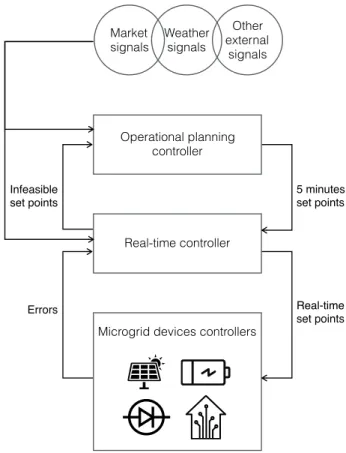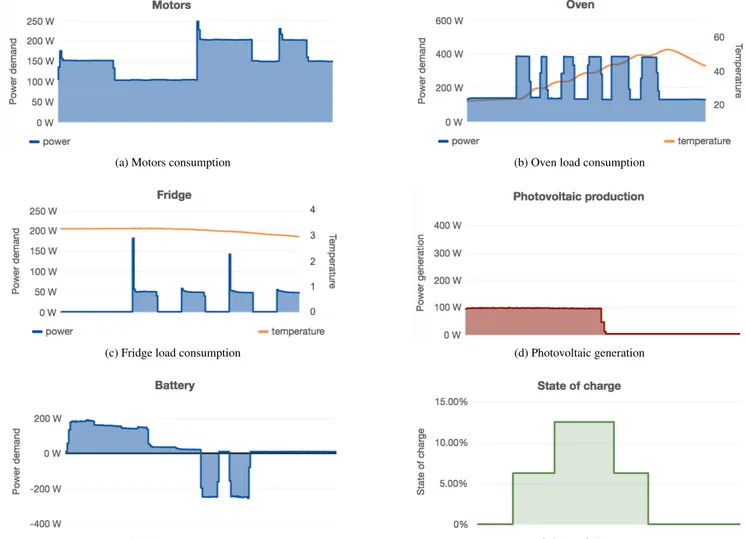24
thInternational Conference on Electricity Distribution
Glasgow, 12-15 June 2017
Paper 0211
EFFICIENT MANAGEMENT OF A CONNECTED MICROGRID IN BELGIUM
Bertrand CORN ´ELUSSE Damien ERNST Luc WARICHET Willy LEGROS
ULg - Belgium ULg - Belgium Nethys - Belgium Nethys - Belgium
{bertrand.cornelusse, dernst}@ulg.ac.be {luc.warichet, willy.legros}@energy.nethys.be
ABSTRACT
The development of distributed generation, the decreas-ing costs of storage means, and the evolution of commu-nication and sensing technologies open new options to the conventional distribution of electric energy, and new options for integrating distributed generation smoothly in constantly evolving energy and ancillary services markets. In this paper, we explore the microgrid possibility, and in particular we detail how we can apply a smart energy man-agement system to a microgrid pilot project in the Walloon region, Belgium.
INTRODUCTION
The development of distributed generation, the decreasing costs of storage means, and the evolution of communica-tion and sensing technologies open new opcommunica-tions to the con-ventional distribution of electric energy with a centralized production dispatched to consumers through transmission and distribution networks, together with new options for integrating distributed generation smoothly in constantly evolving energy and ancillary services markets.
One of these options is the microgrid concept. A micro-grid is a group of interconnected loads and distributed en-ergy resources (i.e. generation or storage) within clearly defined electrical boundaries that acts as a single, control-lable entity with respect to the main grid. It has the ability to connect or disconnect from the grid. When connected, it can offer services to the grid, for instance for balancing the whole power system. A suitable energy management sys-tem (EMS) allows for optimization of the operation of the microgrid and its interaction with the main grid. When the microgrid is connected to the main grid, the EMS plans the operation of generation, storage and demand flexibility so as to capture low energy prices, to export at periods where price is peaking, while maintaining reserves to provide an-cillary services and to anticipate grid failures. It can also encompass other objectives, for instance in case of a ca-pacity price tariff. When disconnected, the objective of the EMS is strictly to keep its components up and running as long as possible given the limited amount of energy avail-able and the lack of inertia provided by the main grid. The EMS also has the key role of ensuring a smooth transition in case of anticipated disconnection or reconnection to the grid. Finally, the EMS can improve energy efficiency of its components.
Obviously, the management of a microgrid with such a
Microgrid External signals PCC Communication pipeline Smart EMS Data
store Controller Frontend
1
Figure 1: An overview of the smart EMS. Top: a schematic representation of the microgrid components, i.e. consumption, storage and generation, connected to the util-ity grid through a smart inverter which can ”route” the en-ergy flows. Bottom: all the information flows organized by the communication pipeline.
smart EMS is a complex task, which from the ICT per-spective (Figure 1), requires a robust backend to organize and maintain all data flows (communication pipeline), a nicely designed frontend to efficiently communicate deci-sions to the people that are in the microgrid, and last but not least, machine learning, optimization and control mod-ules to compute all these control decisions.
The rest of this paper is organized as follows. Section 1 briefly describes the organization of the microgrid project to which these concepts are applied. Section 2 details the different features and modules of the smart energy man-agement system. Section 3 provides first results of the smart EMS on a laboratory reproduction of the microgrid, while Section 4 concludes.
24
thInternational Conference on Electricity Distribution
Glasgow, 12-15 June 2017
Paper 0211
1
THE MERYGRID PROJECT
The microgrid (Figure 2) we are applying these concepts to gathers three SMEs, one is active in the thermal treatment of metals, one is active in the retail and light transformation of wood, and the last builds industrial fans. Two run-of-the-river turbines produce up to 200 kVA, and 60 kWp of PV are installed. The main objectives of the project are
1. to cluster these three companies, their load and gen-eration, so as to make them act as a grid-connected microgrid, i.e. a local energy system that optimizes its energy usage and its interactions with the distri-bution system, the energy and the reserve electricity markets.
2. to build an energy management system that operates the micro-grid in real-time and also takes some pre-ventive decisions regarding commitments to markets, i.e. acts on the demand side, storage systems, and generation.
3. to design, develop and install an energy storage sys-tem (ESS) with battery storage and ultracapacitors.
The project is funded by the Walloon government, with the support of the DGO6, and is built around the following partners: Nethys, the project leader, realizes the necessary investments into the building of the grid; SPI, the local eco-nomic development agency, handles the definition of the administrative and juridical framework that will apply to the grid participants; the University of Li`ege (ULg) devel-ops the software that controls the grid; the research cen-ter Sirris engineers the mechanical envelope for the stor-age system; CE+T designs and realizes the storstor-age system for the microgrid, and MeryTherm represents the group of companies that participates in the microgrid. The local au-thorities of Esneux and the CWAPE (local regulator) are invited to an observation committee.
2
THE SMART EMS
As depicted in Figure 1, the smart EMS gathers data from the sensors placed in the microgrid as well as external sig-nals, such as a price signal from the market, in real-time. The data is channeled to a data store through a commu-nication pipeline, which also feeds the controller and the front-end. Figure 3 details what is inside the controller module. From the smart EMS perspective, microgrid man-agement can be divided into two main tasks. First, opera-tional planningdetermines a strategy for playing in energy and service markets, for interacting with the main grid, and for managing the energy storage devices. Second, real-time control stabilizes the microgrid in case of disconnec-tion from, or reconnecdisconnec-tion to, the main grid. It also allows for following the operational planning decisions, checking
their feasibility, and providing some feedback to the oper-ational planning. In addition to these two tasks, the smart
Operational planning controller
Real-time controller
5 minutes set points
Microgrid devices controllers
Real-time set points Infeasible set points Errors Market signals Weather signals Other external signals 2
Figure 3: Inside the controller of the smart EMS. EMS also checks the validity of the data and reports alerts to the other modules.
2.1
Operational planning
Operational planning (OP) is a perpetual process (Figure 4) composed of three main modules.
The first module uses historical data and external informa-tion to build forecasting models that estimate the genera-tion and consumpgenera-tion of the microgrid components. More precisely, this module not only generates a prediction for each variable of interest, but a fan of scenarios representing probable evolutions of these variables [1].
The second module uses all these scenarios, the param-eters defining the microgrid components, and information regarding preferences of the users, and determines a sched-ule for the next few hours. This modsched-ule shares many sim-ilarities with the active network management principle as defined in [2]. If a market period is 15 minutes long, as this is the typical duration used for settlement in Belgium, then, every 15 minutes, an optimization problem is solved over the different possible scenarios. The objective of the prob-lem is to achieve a trade-off between several goals, such as
24
thInternational Conference on Electricity Distribution
Glasgow, 12-15 June 2017
Paper 0211
Figure 2: A satellite view of the Merygrid site.
energy prices, provision of reserve, or the peak price. The constraints model the feasible modes of the power elec-tronics module, the constraints of the battery storage, and the constraints that model the flexibility of the consumer devices, and the provision of reserve. At certain specific times, the operational planning module has to take into ac-count the sequence of options that are offered to the micro-grid, such as taking a position on the energy market, retain-ing some margin for providretain-ing ancillary services, etc. [3]. The first two modules are represented by theM -boxes in Figure 4, which represents the receding horizon approach, the sequence of actions at, and the evolution of the state of
the microgrid st, of the uncertainty wt, and of the rewards
rtwhich are maximized.
t ℳt at st ℳt+1 t t+1 st+1 at+1 ℳt+2 t t+1 t+2 at+2 st+2 rt rt+1 wt⇠ pW(·) st+1= f (st, at, wt) wt+1⇠ pW(·) st+2= f (st+1, at+1, wt+1)
⌃
max 1Figure 4: The receding horizon approach for OP.
The third module aims at detecting whether the parame-ters of the model or the estimated state of the microgrid
components used for OP are correct. To achieve this, this module compares the set points communicated to the real-time controller and the feedback provided by the latter (the measured errors).
2.2
Real-time control
Real-time control solves a problem similar to the optimiza-tion problem in the operaoptimiza-tional planning module. How-ever, it is at a much higher frequency, on a more detailed system model, with a shorter time horizon, and with less uncertainty. In particular, the approach followed is simi-lar to [4], where an MPC framework is set up to minimize the tracking error from the set-points communicated by OP while satisfying the real-time constraints associated to the microgrid devices, such as the transient currents of motors, the charging modes of the battery storage systems, etc. The power electronics interfaces of the devices, such as the so-lar panel inverters and the (dis-)charging system of the bat-tery, have their own logic, but the real-time controller can send them some set points or some configurations, such as curtailment instructions or operation modes.
3
FIRST RESULTS
The first results are obtained on a laboratory reproduction of the actual microgrid, as depicted in Figure 5. This figure shows the realized set points of the loads and of the battery given a forecast of solar generation. In this scenario, a set of motors have flexibility on the starting time, a fridge can be switched off as long as the temperature remains accept-able, and a set of jobs must be achieved in the oven. During the simulation, the battery is able to inject energy into the utility grid when the price is relatively high.
24
thInternational Conference on Electricity Distribution
Glasgow, 12-15 June 2017
Paper 0211
(a) Motors consumption (b) Oven load consumption
(c) Fridge load consumption (d) Photovoltaic generation
(e) Battery power (f) State of charge
Figure 5: Planned and realized setpoints.
4
CONCLUSION
We have presented the concepts of the microgrid that is being implemented within the Merygrid project. In partic-ular, we are developing an ambitious energy management system that constantly attempts to determine the best op-tions to create some value from the energy and ancillary service markets while at the same time ensuring a robust operation of the microgrid.
ACKNOWLEDGMENTS
This research is supported by the public service of Wallo-nia (DGO6) within the framework of the MeryGrid project.
REFERENCES
[1] Q. Gemine, B. Corn´elusse, M. Glavic, R. Fonteneau, and D. Ernst, “A gaussian mixture approach to model stochastic processes in power systems,” in Proceed-ings of the 19th Power Systems Computation Confer-ence (PSCC’16).
[2] Q. Gemine, D. Ernst, and B. Corn´elusse, “Active net-work management for electrical distribution systems: problem formulation, benchmark, and approximate solution,” Optimization and Engineering, pp. 1–43, 2016, ISSN: 1573-2924. DOI: 10 . 1007 / s11081 -016 - 9339 - 9. [Online]. Available: http : / / dx . doi.org/10.1007/s11081-016-9339-9.
[3] A. J. Conejo, M. Carri´on, and J. M. Morales, Deci-sion making under uncertainty in electricity markets. Springer, 2010, vol. 1.
[4] H. Soleimani Bidgoli, M. Glavic, and T. Van Cutsem, “Receding-horizon control of distributed generation to correct voltage or thermal violations and track de-sired schedules,” in 19th Power Systems Computation Conference (PSCC 2016), Power Systems Computa-tion Conference, 2016.



